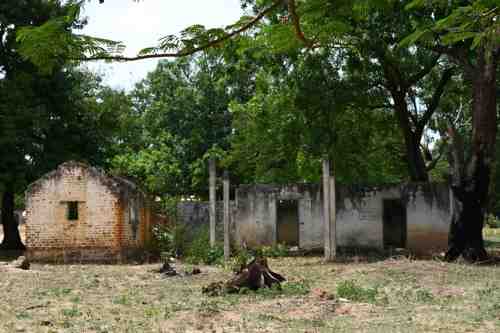
Overview
In this lesson, students will explore the concept of peacebuilding on both an international and local level. Students will use what they have learned to evaluate existing peacebuilding efforts in their community, and take initiative to suggest peacebuilding projects of their own.
You can also print a PDF of this lesson plan.
Curriculum Standards (Common Core State Standards)
Reading
Key Ideas and Details
1. Read closely to determine what the text says explicitly and to make logical inferences from it; cite specific textual evidence when writing or speaking to support conclusions drawn from the text.
2. Determine central ideas or themes of a text and analyze their development; summarize the key supporting details and ideas.
Integration of Knowledge and Ideas
Integrate and evaluate content presented in diverse formats and media, including visually and quantitatively, as well as in words
Range of Reading and Level of Text Complexity
Read and comprehend complex literary and information texts independently and proficiently.
Speaking and Listening
Comprehension and Collaboration
1. Prepare for and participate effectively in a range of conversations and collaborations with diverse partners, building on others' ideas and expressing their own clearly and persuasively.
2. Integrate and evaluate information presented in diverse media formats, including visually, quantitatively, and orally.
History and Social Studies
Key Ideas and Details
1. Cite specific textual evidence to support analysis of primary and secondary sources.
2. Determine the central ideas or information of a primary or secondary source; provide an accurate summary of this source distinct from prior knowledge or opinions.
Craft and Structure
1. Determine the meaning of words and phrases as they are used in a text, including vocabulary specific to domains related to history/social studies.
Integration of Knowledge and Ideas
1. Integrate visual information (e.g., in charts, graphs, photographs, videos, or maps) with other information in print and digital texts.
2. Distinguish among fact, opinion, and reasoned judgment in a text.
Time Required
Two 45-minute classes or one 90-minute block. Background Information and article exploration (45 minutes); Local Connections (45 minutes)
Materials
- Chart paper
- Student subject-area notebooks or journals
- Internet Access or map and country profile print-outs
- Articles:
- "An Experiment in Building Peace" by Jina Moore
- "In Chicago, Talking Sense to Angry Young Men" by Richard Mertens
Student Preparation
Assign the following questions for homework:
- Explain what the term "peacebuilding" means to you.
- Where in the world do you believe peacebuilding is happening? Why?
- How does peacebuilding look in these countries?
- Do you see examples of peacebuilding in your community?
- How does peacebuilding look in your community?
- Provide students with a map of Africa; ask them to identify the countries of Sierra Leone, Burundi, the Central African Republic, and Guinea Bissau.
Anticipatory Set
1. Working with partners or in small groups, have students share their answers to the homework questions.
2. Write "Peacebuilding" on a large piece of chart paper, and ask groups to share their definitions. Once every group has shared how they define the term; ask each group to share an international and local example of peacebuilding (if they were able to generate an example).
Procedures
Background Information
- Using a world map, help students identify the countries of Sierra Leone, Burundi, the Central African Republic, and Guinea Bissau.
- Depending on the readiness of your students/instructional time available, you can put together a brief country-profile presentation touching on geography, population, people, economy, history, etc. of each nation, or ask the students to create brief over-views of the countries. Jina Moore has a brief description of the Central African Republic among her reports: Peace in Central Africa and the U.S. Department of State has a user-friendly page of basic country information: Country Background Notes.
- Once the students have a better understanding of the four nations, ask students to discuss the common strengths they see in the countries as well as the common struggles and needs facing each nation.
"An Experiment in Building Peace"
- As a whole group, read through and discuss Jina Moore's work on U.N Peacebuilding efforts in four African nations: An Experiment in Building Peace
- Ask students to return to their journals/subject-area notebooks and answer the following questions:Moore refers to the notion of "sustainable peace," what does this term mean to you?
- What is being done to build sustainable peace in one of the nations we discussed today?
- In your opinion, why is peacebuilding a challenge in each country?
- In your opinion, why do you believe peacebuilding is necessary in each nation?
- Provide each student with a Post-It Note or square of paper, and ask them to share their definition of sustainable peace, and why they believe it is necessary, by writing it on the piece of paper, and then sticking/taping it to a large piece of chart paper with the term "Sustainable Peace" on it.
Local Connections
- Ask students to focus on the second-to-last paragraph of Moore's article in which she discusses the need for effective government, health care, economic, social aid systems in the four African nations targeted by the U.N. Peacebuilding efforts. As a group, discuss why these systems would play such a crucial role in establishing sustainable peace in these countries.
- Ask students to reflect on how these same systems (health care, schools, jobs, police support, local government) look in their community. Are they functional? Are the services they provide meeting the needs of the community?
- Provide students with time to reflect on the following questions related to peacebuilding in their community. These questions may be answered independently in the students' journals, in small groups, or as a large group.
- In your opinion, which of these systems work in your community? Please provide a specific example.
- In your opinion, which of these systems do not work? Please provide a specific example.
- What role do you believe you need to play in making these systems more effective?
- Will increasing the effectiveness of these systems build sustainable peace in your community? Why or why not?
- How could you play a role in improving one or more of these systems?
Local Connections in the Media
- Provide students with a copy of "In Chicago, Talking Sense to Angry Young Men with Guns," a June 2008 article by Richard Mertens in the Christian Science Monitor describing CeaseFire one of the anti-violence organizations working to support Chicago youth, and keep neighborhoods safe. Ask students to read the article with a partner, small group, or with the whole class. As they read, students should reflect on the following question:
- Is this an example of a successful system in your community? Why or why not?
- As a whole group, discuss and record other systems which do/do not work towards building peace in Chicago. These systems can range from large-scale organizations such as city government agencies and national corporations; to smaller-scale projects such as churches, sports leagues, and school support groups; to individual-efforts by teachers, coaches, and religious leaders.
- Ask students to discuss what makes certain organizations succeed while others (sometimes with significantly more funding) fail. Allow students to discuss if they believe the U.N. faces similar difficulties as they work to build peace in the four African nations discussed at the start of the lesson.
Conclusion
Conclude the lesson by providing students with a new Post-It Note or square of paper, and ask them to list at least one way in which they feel empowered to build a sustainable peace in their community, a way in which they will commit to building peace. Write "I will help to build sustainable peace in my community by..." on a piece of chart paper, students may choose to post the note openly or post it folded in half and sealed.
Glossary of Important Terms
- UN – United Nations
- PBC – Peacebuilding Commission
- Peacebuilding
- Sustainable Peace
Assessment Options
1. Peace Journal
Ask the students to commit to one month of local peacebuilding. They can keep a journal (written, photo, video) to document their efforts, and the efforts of those around them, to bring peace to their neighborhood or community. At the end of a month, meet with the students individually to review their efforts and discuss areas of success or difficulty. Are they able to make a renewed commitment? Would they like to incorporate other local agencies or organizations?
2. Letter Writing Assignment:
The student will compose a letter to a local government official requesting support for improved systems (health care, jobs, police, schools, etc.) in their community. The student should outline why they believe the system requires improvement, how they feel this improvement could be made, and the results they anticipate if necessary resources are provided.
OR
Identify a "Local Hero" award or weekly spotlight in a school, community, or local newspaper or on a nightly news program, and ask the student to nominate an individual they feel has worked hard on behalf of peacebuilding in their community. The student should outline specific ways in which this individual has contributed to the betterment of their community, and clearly demonstrate why they are deserving of recognition. The class could hold a brunch or after-school event to honor all of the nominees.




